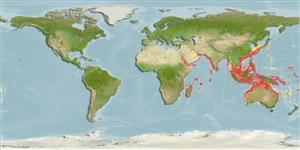Common names from other countries
Environment: milieu / climate zone / depth range / distribution range
Ecologie
marien; brak water demersaal; diepte 10 - 400 m (Ref. 11441). Tropical; 26°C - 29°C (Ref. 4959)
Indo-West Pacific: Persian Gulf (Ref. 11441), off Pakistan, the west coast of India and Sri Lanka, Indonesia, the Philippines, Japan, and the north and east coasts of Australia.
Grootte / Gewicht / Leeftijd
Maturity: Lm ? range ? - ? cm
Max length : 44.0 cm SL mannelijk / geslacht onbekend; (Ref. 559); common length : 30.0 cm TL mannelijk / geslacht onbekend; (Ref. 2872); max. gepubliceerd gewicht: 61.90 g (Ref. 124479)
Dorsale stekels (totaal) : 0; Dorsale zachte stralen (totaal) : 107 - 113; Anale stekels: 0; Anale zachte stralen: 80 - 88. Eyed side brown with an irregular dark blotch on gill cover, blind side white. Blind side with 2 lateral lines (dorsal and medial). Body elongate, its depth 22 to 29% SL. Eyes with a small scaly interorbital space. Snout rounded. Rostral hook short. Corner of mouth reaching posteriorly beyond lower eye, nearer to gill opening than to tip of snout. Caudal-fin rays usually 12. Midlateral-line scales 88 to 96. Scales ctenoid on eyed side of body. Cycloid on blind side. Scale rows between lateral lines on eyed side of body 13 to 16 (Ref 9895).
Occurs in coastal areas and estuaries. May ascend upstream into the freshwater tidal zone of the Mekong (Ref. 12693). Inhabits muddy and sandy bottoms of continental shelves. Feeds mainly on benthic invertebrates (Ref. 3391). Utilized as a food fish (Ref. 3391). Marketed fresh in the Mekong delta (Ref. 12693).
Menon, A.G.K., 1977. A systematic monograph of the tongue soles of the genus Cynoglossus Hamilton-Buchanan (Pisces: Cynoglossidae). Smithson. Contrib. Zool. (238):1-129. (Ref. 5297)
Status op de Rode Lijst van het IUCN (Ref. 130435)
CITES (Ref. 128078)
Not Evaluated
Gevaar voor de mens
Harmless
Gebruik door de mens
Visserij: commercieel
Tools
Speciale rapporten
Download XML
Internetbronnen
Estimates based on models
Preferred temperature (Ref.
115969): 16.9 - 28, mean 23.8 (based on 942 cells).
Fylogenetische diversiteitsindex (Ref.
82804): PD
50 = 0.5000 [Uniqueness, from 0.5 = low to 2.0 = high].
Bayesian length-weight: a=0.00417 (0.00262 - 0.00664), b=3.05 (2.91 - 3.19), in cm Total Length, based on LWR estimates for this species & Genus-body shape (Ref.
93245).
Trofisch niveau (Ref.
69278): 3.9 ±0.32 se; based on food items.
Weerstandsvermogen (Ref.
120179): Gemiddeld, minimale populatieverdubbelingstijd 1,4-4,4 jaar (Fec = 2,223-225,557).
Fishing Vulnerability (Ref.
59153): Moderate vulnerability (41 of 100).
